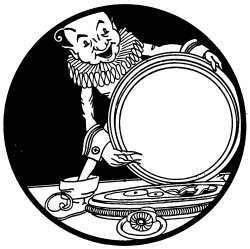The Box of Wonders in Your Pocket, Part 2
 Read Part 1 here
Read Part 1 here

The Box of Wonders in Your Pocket, Part 2
|

|

|
From The Watch Word, November 1935 |
|
||
|
Another test is for position, and this is usually taken in five ways: First, while lying flat with the face up, then with the face down, next hanging straight, then hanging with the stem to the right, then with the stem to the left. These tests for position are the most important. Before each one, the watch -for the "movement" is a complete watch except for the case-is set by a "master clock." At the end of the test, a record is made of the Time it has kept in each position. If there is any variation, we make certain changes and repeat the tests until the watch keeps the same Time in all positions. Every watch is rated in this manner before it leaves the factory. Yet when you buy a watch and begin to wear it, it may gain or lose twenty or thirty seconds a day; perhaps even more. You think this doesn't look as if it had been rated properly. But that is an entirely different matter. Your new watch gains or loses regularly-a constant error. It does not p,ain on some days and lose on other days. What the watch rater does is to make sure that it will run regularly under all conditions and in all positions. Even when this has been done, a watch may show a constant loss or gain when it is carried. Each person, for instance, has an individual gait in walking. Some people walk rapidly, others slowly. Some walk heavily, others lightly. Some are very inactive, others always on the move. A watch may keep perfect Time while hanging on a board at the jeweler's, yet gain or lose when you begin to carry it. Or it may keep perfect Time for one person and not for another. Every watch must be adjusted to the individual who carries it. |
|
|||
|
At the center of the hairspring is a very small steel staff with a pivot at each end. . These pivots are beautifully made ane finished; yet they are only 28 tenthousandths of an inch in diameter! Suppose you drop your watch on the floor. Is it strange that the shock may break or bend one of these needle-like pivots? That is perhaps the commonest accident which causes trouble with a watch. The wonqer is that the delicate parts so seldom give way under the treatment most watches receive. If the pivots stand the shock, the severe jar may crack one of the tiny jewels on which the points of the pivots work. If that does happen, your watch may stop entirely, or it may refuse to run in certain positions where the pivot will catch in the cracked jewel. A sudden jar may change the angle of the jewel to the pivot; change it by less than a hair's breadth. But the adjustment is so delicate that even' this microscopic change in position will stop your watch, or make it run irregularly. The subject of watch cleaning is one about which most people are tempted to argue. Why should a watch not go a number of years without this attention, if it continues meanwhile to give satisfaction? Because, as has already been pointed out, no other machine is asked to run continuously for such long periods. The constant friction dries the oil that lubricates the movement, or it makes this oil gummy, causing the delicate hairspring to work harder. If the oil dries up, the metal parts without jewels rub against each other, and gradually wear away. A watch should be cleaned and oiled at least once every year, and the smaller models oftener. The process is not an easy or simple one. The entire movement is taken apart and the pieces are washed in a solution of gasoline, which removes the dirt and oil. A watch repairer should be an expert. For instance, a little cyanide is often used in this bath; but if the parts are allowed to remain in it a little too long, they will be corroded by the chemical. After the parts have been cleaned with gasoline, they get an alcohol bath and are dried in a special kind of sawdust. When they have been reassembled, they are carefully oiled. The oil used in watches - or that which should be used - comes from a cavity in the jaw bone of the porpoise or the blackfish. The best quality is rare. Cape Cod fishermen bring in most of it. To be tested, it is taken up into Vermont, where the mercury often goes far below zero. The best grade is that which remains practically unchanged at these low temperatures. A single drop of this oil is enough to lubricate a watch. There is a common impression that watches are affected by the "personal magnetism" of the people who carry them, but there seems to be no foundation for that idea. In this connection, however, there is one interesting and little known cause of watch trouble. If you shouldn't chance to get into what is known as a magnetic field, your watch is likely to become magnetized, with the result that you will find it playing you some curious tricks. The occurrence of these magnetic fields seems to be a matter of chance. You may ride on an electric car, or stand near a third rail, or work in an electric plant for years and not happen to get into such a field. On the other hand, you may be in one of them at any time. If you are curious to know whether your own timepiece is magnetized now, place a very small compass over the movement. If the needle does not point due North when it should, take the watch to a good jeweler and have him demagnetize it by means of a device invented for this purpose. Another common impression is that in setting a watch you never should turn the hands backward. But turning the hands backward will not injure any timepiece (except one that strikes), if the hands are fitted with correct tension. In a striking clock there is a hook which catches on a certain part of the mechanism, causing it to strike. If you turn the hands of such a clock backward, this hook may catch in other parts and cause trouble. But there is no such danger in a watch unless it is a "repeater." Wind your watch regularly. The best time is in the morning, for two reasons. You are more likely to have a regular hour for rising than for going to bed. And, also, a spring that is fully wound is less sensitive to the jars and strains of your active day. On the face of some watches, above the small dial for the second hand, there is another dial which shows how long the watch has been running since it was wound. Another "extra" in some watches is an additional hour hand. It is finished in red, to distinguish it from the usual hour hand of blue, black or gold. This extra hand is most often used on watches carried by railroad men whose train-run extends past some point where the Time changes an hour; from Eastern Time to Central, for instance. The regular hand gives them one Time, the red hand gives the other. In the mix-up caused by some cities adopting daylight-saving Time while the railroads kept the old Time, men who travel have found these two hands very convenient. The regular hand indicates city Time, the red one railroad Time. If your watch is gaining or losing, take it to a competent watchmaker and let him do the regulating. Should you be obliged to perform the operation yourself, use extreme care in doing it. You can see in the back of your watch the pin, or pointer, which must be moved toward F (fast) if your watch has been losing Time, or toward S (slow) if it has been gaining. But touch this pointer gently and move it as short a distance as you possibly can. Never open the back of your watch when you are out of doors, or where the air is full of dust. After opening it, carefully replace the back and be sure you close it completely. Do not press on the center of the case, back or front, in closing it. Press on the edges. After the regulator has been moved, wait several days before making any further change. This is important. A certain length of Time is necessary to show just what the results of the new adjustment will be. Never press on the crystal of your watch. You will be likely to break it if you do. If it is broken, or even cracked, have a new crystal put in immediately, as the dust which gets on the dial may find its way to the movement. When you carry your watch in your pocket, have the face next to you in order to protect the crystal. Keep your watch pocket free of lint and dust. Don't give your watch to the baby. Don't take a bath or shower, or go in swimming, without first removing your wrist watch. This may seem an unnecessary piece of advice, but some persons need it. In short, have a heart! Think of those microscopic pivots and jewels you may break, and of the delicate adjustments you may disturb. It requires 3,773 operations for us to make a watch. The average Time which elapses from the beginning to the completion of the process is a year. Yet by a moment's carelessness you may destroy the efficiency which is the result of all this Time and effort. |
||||
|
||||
|
|
||||

|
|
|||
|
|
||||
Comments to jsexton@elgintime.com